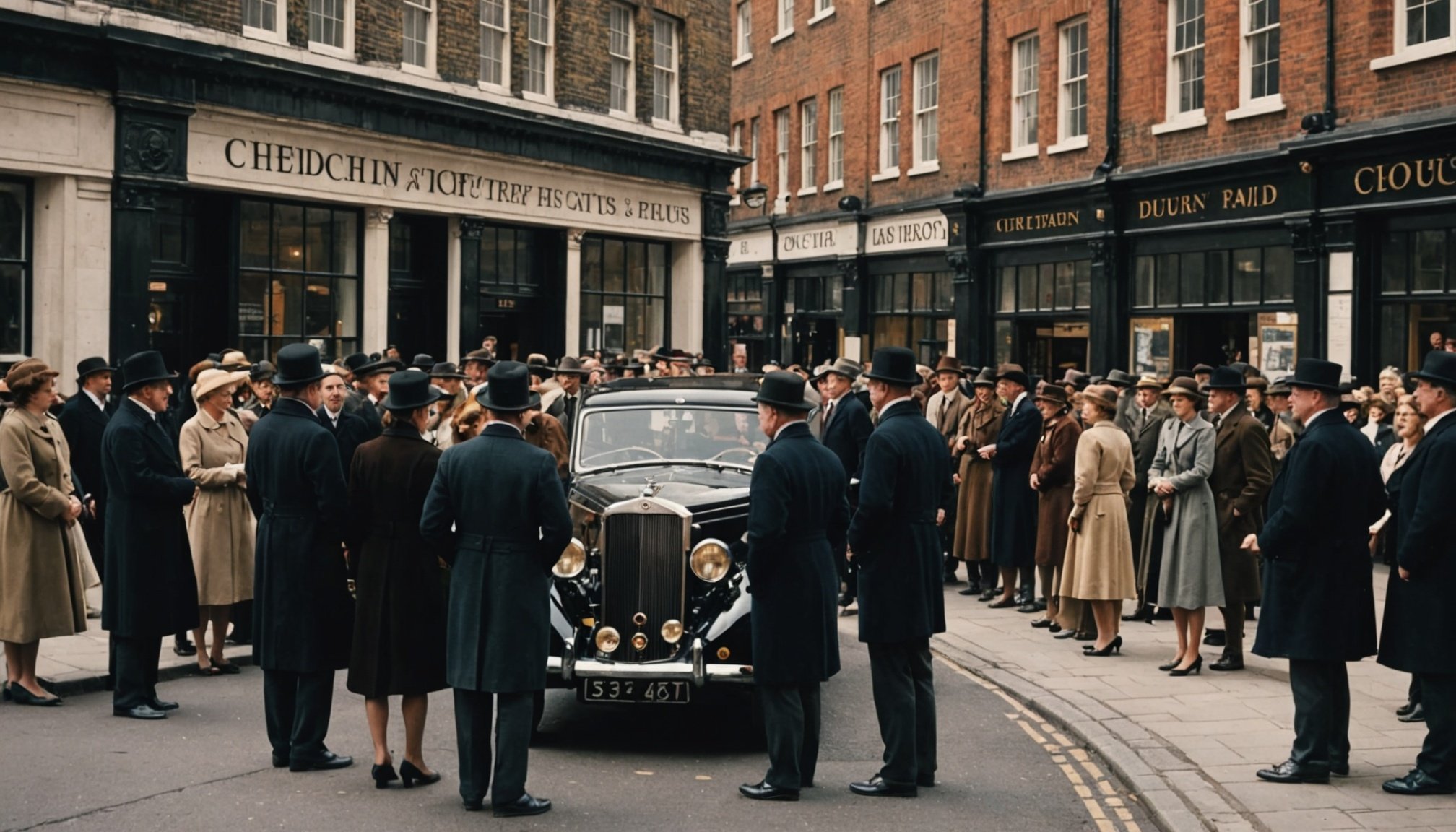Overview of London’s Cinematic Heritage
London’s cinematic history is rich and varied, having significantly impacted global cinema. British cinema, with its unique storytelling and artistic flair, gained a reputation for quality and innovation. The 1940s saw pivotal shifts with movements like British New Wave, which brought realism to the forefront, challenging norms and influencing future filmmakers. This era emphasised Britain’s post-war socio-economic conditions, portrayed with sensitivity and skill.
Particular films have carved special niches within the cultural psyche, influencing perceptions worldwide. Classics such as “Lawrence of Arabia” and “A Clockwork Orange” remain iconic. These films not only showcased British narrative strength but also highlighted London’s rich tapestry of locations, confronting societal themes that resonated globally.
Also to discover : Unlock the secrets of france: your comprehensive travel guide
Film legacy in Britain is epitomised through evolving trends, adapting to technological advancements while retaining its core essence. This adaptability has ensured British films remain relevant and continue to engage audiences. London’s role as a cultural hub extends beyond geography; it’s a living canvas for filmmakers, bridging historical charm with contemporary dynamism.
In essence, the legacy of British cinema and its movements define London’s film heritage, positioning it as a beacon in the cinematic landscape.
Also to discover : Discover London’s Regal Residences: Embark on a Historic Journey with Expert-Led Tours
Notable Film Locations in London
London is a treasure trove of iconic film locations, offering cinematic backdrops ranging from historic landmarks to urban marvels. Famous sites like Buckingham Palace have appeared in numerous films, symbolising Britain’s heritage and royal charm. Its cinematic allure makes London ideal for portraying film locations that require grandeur and prestige.
Landmark Film Locations
Immortalised on the silver screen, locations like the Tower Bridge are more than just filming backdrops; they carry immense historical significance in cinema. These sites leave an indelible mark on movie-goers, becoming symbols of British and global storytelling. When visiting these iconic locations, it’s recommended to explore their historical context to fully appreciate their cinematic history and varied uses in film.
Lesser-Known Film Spots
Film enthusiasts should venture beyond the mainstream to discover London’s hidden gems. Areas like Notting Hill, with its famous blue door, offer quaint charm and intimacy, often chosen for productions needing an authentic, local feel. These filming locations are accessible and provide unique insights into why they were selected for particular movies. Always check accessibility details to ensure a smooth visit.
Guided Tours of Historic British Film Sites
Guided tours of historic British film sites offer a unique glimpse into the rich history and influence of London’s cinematic landscape. Numerous options cater to different interests, giving film enthusiasts a chance to experience the cultural context of iconic films firsthand.
Independent vs. Major Tour Operators
When choosing between independent and major tour operators, consider the type of experience you are looking for. Independent tours often provide a more personalised and intimate encounter, with guides who may offer unique anecdotes and a deep passion for the subject matter. Conversely, major operators might focus on broader cinematic themes and are likely to cover a wide range of popular film locations.
Unique Experiences on Offer
Each film tour offers distinct experiences. Some focus on specific genres, taking you through the evolution of horror or romance films shot in London, while others might highlight the locations of world-renowned classics. Guided by experts, these tours often provide exclusive behind-the-scenes stories and insights into the filmmaking process. Participating in one can deepen your appreciation for the artistry and passion that drive London’s vibrant film industry.
Self-Guided Film Tour Itineraries
Embarking on a self-guided tour allows film enthusiasts to explore London’s rich cinematic tapestry at their own pace. Designing itineraries suited to diverse interests can enhance the experience, focusing on the film location maps that pinpoint key sites.
Itinerary for Film Buffs
An engaging route for film buffs should cover major film sites like Trafalgar Square or Piccadilly Circus, offering detailed descriptions of their cinematic significance. Each location has featured in numerous films like “V for Vendetta” and “Harry Potter,” blending historic allure with modern storytelling. Allocate sufficient time to truly immerse yourself, estimating around 30-40 minutes per site.
Exploring Specific Genres
For those captivated by particular genres like horror or romance, thematic itineraries can spotlight films such as “28 Days Later” or “Love Actually,” where locations set the scene for pivotal moments. Incorporating nearby attractions and dining can enrich the journey, fostering a complete cultural experience.
Useful Resources and Maps
Utilising digital resources and mobile applications can dramatically enhance self-guided tours. These tools provide real-time navigation and enriched content about each site. With handy maps detailing film spots, tourists can effortlessly discover London’s cinematic secrets while avoiding less accessible areas.
Film Festivals in London
Film festivals in London are a vibrant showcase of British and international cinema, drawing film enthusiasts and industry professionals from around the globe. Each year, festivals like the BFI London Film Festival celebrate a diverse array of films, highlighting both emerging talents and renowned filmmakers. These events also provide a significant platform for promoting local film culture, offering workshops, panel discussions, and networking opportunities that enrich the cinematic community.
Participating in these festivals is an excellent way to immerse oneself in the dynamics of filmmaking and gain insider perspectives on the industry. Upon attending, expect to experience a wide variety of genres, ranging from compelling documentaries to short films, each contributing to the overall tapestry of British cinema.
For those interested in joining, it’s advisable to book tickets in advance due to high demand. These festivals often offer festival passes or day tickets, along with options for students or group discounts. Engaging with London’s film festivals not only celebrates cinema but deepens the understanding of cultural narratives and the art of filmmaking.
Personal Insights and Anecdotes from Filmmakers
The vibrant city of London offers filmmaker insights into its rich and dynamic film industry. Those behind the camera frequently reflect on the city’s profound impact on storytelling and film production. A common theme in these reflections is the ability of London’s diverse locations to adapt and enhance narratives, providing a visual palette that filmmakers find both challenging and inspiring.
In their behind-the-scenes stories, many directors and producers recount how London’s iconic and lesser-known spots influence the tone and style of their films. For instance, the gritty urban landscapes can amplify a storyline’s tension, while the historic architecture often provides a dramatic backdrop for period dramas.
Filmmakers frequently discuss the evolution of the film industry within London, noting the city’s ability to blend the past with the present. This adaptability invites a broad spectrum of projects, from ambitious blockbusters to intimate indie films. Stories from set often highlight the camaraderie and creative exchange that London’s film environment fosters, making it a cherished hub for visionary cinema. These personal accounts not only spotlight the city’s cinematic allure but also underscore its ongoing contribution to global film culture.




